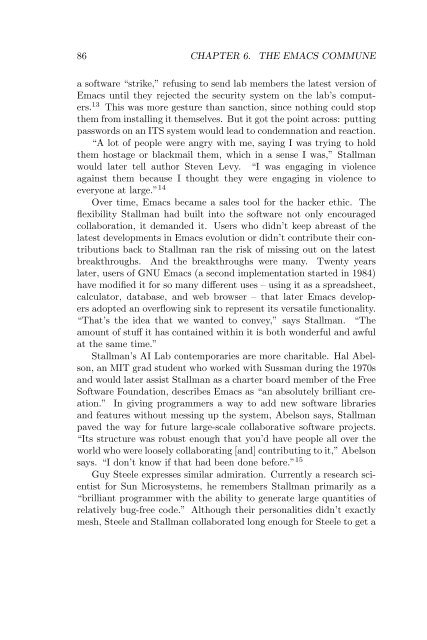Create successful ePaper yourself
Turn your PDF publications into a flip-book with our unique Google optimized e-Paper software.
86 CHAPTER 6. THE EMACS COMMUNE<br />
a software “strike,” refusing to send lab members the latest version of<br />
Emacs until they rejected the security system on the lab’s computers.<br />
13 This was more gesture than sanction, since nothing could stop<br />
them from installing it themselves. But it got the point across: putting<br />
passwords on an ITS system would lead to condemnation and reaction.<br />
“A lot of people were angry with me, saying I was trying to hold<br />
them hostage or blackmail them, which in a sense I was,” Stallman<br />
would later tell author Steven Levy. “I was engaging in violence<br />
against them because I thought they were engaging in violence to<br />
everyone at large.” 14<br />
Over time, Emacs became a sales tool for the hacker ethic. The<br />
flexibility Stallman had built into the software not only encouraged<br />
collaboration, it demanded it. Users who didn’t keep abreast of the<br />
latest developments in Emacs evolution or didn’t contribute their contributions<br />
back to Stallman ran the risk of missing out on the latest<br />
breakthroughs. And the breakthroughs were many. Twenty years<br />
later, users of GNU Emacs (a second implementation started in 1984)<br />
have modified it for so many different uses – using it as a spreadsheet,<br />
calculator, database, and web browser – that later Emacs developers<br />
adopted an overflowing sink to represent its versatile functionality.<br />
“That’s the idea that we wanted to convey,” says Stallman. “The<br />
amount of stuff it has contained within it is both wonderful and awful<br />
at the same time.”<br />
Stallman’s AI Lab contemporaries are more charitable. Hal Abelson,<br />
an MIT grad student who worked with Sussman during the 1970s<br />
and would later assist Stallman as a charter board member of the Free<br />
Software Foundation, describes Emacs as “an absolutely brilliant creation.”<br />
In giving programmers a way to add new software libraries<br />
and features without messing up the system, Abelson says, Stallman<br />
paved the way for future large-scale collaborative software projects.<br />
“Its structure was robust enough that you’d have people all over the<br />
world who were loosely collaborating [and] contributing to it,” Abelson<br />
says. “I don’t know if that had been done before.” 15<br />
Guy Steele expresses similar admiration. Currently a research scientist<br />
for Sun Microsystems, he remembers Stallman primarily as a<br />
“brilliant programmer with the ability to generate large quantities of<br />
relatively bug-free code.” Although their personalities didn’t exactly<br />
mesh, Steele and Stallman collaborated long enough for Steele to get a


